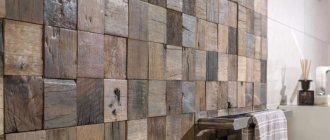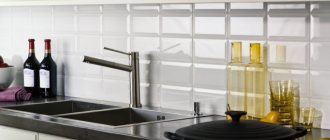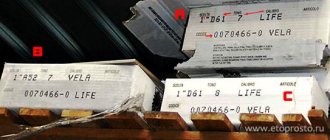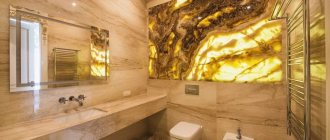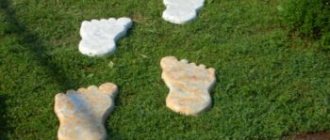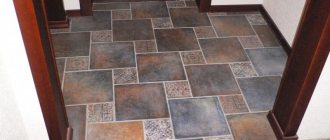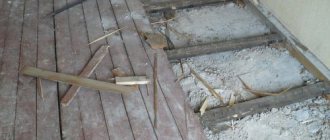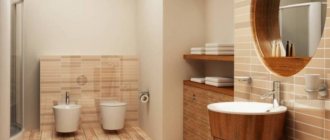PVC quartz vinyl floor tiles
Are there any features and differences in the installation of quartz-vinyl tiles Fine Floor and other types of floor tiles - porcelain tiles, tiles, PVC?
Are the labor and cost of the work similar or different? What's the point of such a tile? some kind of chopped linoleum
Svetlana-NM wrote: Are there any features and differences in laying quartz-vinyl tiles Fine Floor and other types of floor tiles - porcelain stoneware, tiles, PVC? Are the labor and cost of the work similar or different?
linoleum cut into squares must be laid on a perfectly level surface. The tile, by itself, forms a flat surface. IMHO tiles are more reliable than cut linoleum, but again, you can’t put tiles in rooms, but linoleum is mona!
quartz vinyl is laid like PVC tiles. PVC adhesives, flat base, A2 spatula (if the base is absorbent), etc.
valid7228 wrote: linoleum cut into squares must be laid on a perfectly level surface. The tile, by itself, forms a flat surface. IMHO tiles are more reliable than cut linoleum, but again, you can’t put tiles in rooms, but linoleum is mona!
They put it everywhere, that’s the point. The characteristics are good, not everyone knows.
Thanks a lot. Doesn't it last long?
Svetlana-NM wrote: They put it everywhere, that’s the point. The characteristics are good, not everyone knows.
For example, what is the point of putting it in the bathroom?? there is a need for tiles.
valid7228 wrote: what is the point of putting it in the bathroom, for example?? there is a need for tiles.
Why? It is not afraid of water and can be installed easily and quickly. We laid it out in one test room without glue to see how it looked. Even without glue it lies quite firmly
What I mean is that if the walls in the bathroom are made of tiles... what's the point of having a floor made of cut linoleum?
in the bathroom you need waterproof glue, and these are either solvent-based contacts or 2-k. LVT (designer) tiles are available in such a way that many people prefer them to ceramic tiles.
By the way, thank you. for the idea. I just have a hallway, hallway, kitchen, they have a complex configuration. If I bought linoleum as I wanted, then I would have to take about 4 meters of it, but how to bring it in, I kept racking my brains. and it would be difficult to cut it
valid7228 wrote: if the walls in the bathroom are made of tiles..what is the point of a floor made of cut linoleum?
Weird question. In your opinion, it turns out that walls and floors should be made of the same material?
Why are you being so derogatory?
natural (50x50 or 33x33). full in the form of lamellas, there is 50x50. There are good designs, there are 3D, wood, glass, metal, stone. Now I’ll see what I have from quartz vinyl.
gans gr wrote: in the bathroom you need waterproof glue
Yuri, the seller recommended Forbo 522 glue to us when we bought these tiles (a year ago). They used it in two rooms. Is this glue suitable for the bathroom?
I ran through Yandex. They sell only in Moscow, we don’t have them in Orekhovo-Zuevo, and the price is from 500 rubles (a la laminate) and up to 1000 for expensive parquet, stone and other patterns.
Howlin, sellers everywhere offer this glue and builders use it for everything, it’s very convenient. easily under household loads. if TP and tiles are not needed. I don’t allow it to be used in the bathroom (although a lot of people still use it). in the bathroom, if used, be sure to go through the perimeter with sealant and lay it without gaps.
gans gr wrote: I do not allow it to be used in the bathroom
Why?
gans gr wrote: be sure to seal the perimeter with sealant
Perimeter of the room? What sealant should I use? And what glue is better for the bathroom then?
522 is a dispersion; long-term exposure to water destroys it (it gets wet and loses its adhesive force), the tile will begin to lift the edges, etc. any sealant, the main thing is that it is smellier and less natural. contact glue is best neoprene, they are not afraid of water, ours is 233 (though it smells of solvents when working). When working outdoors, they use 2-k adhesives, but they are not so easy to work with (reactionary, i.e., limited lifetime, do not have an initial adhesive strength and if they are dirty, it is necessary to immediately remove the dirt; after setting, they can only be removed mechanically). But these adhesives can even be used to cover a swimming pool.
gans gr wrote: long-term exposure to water destroys
It's clear. Just what is “long-term exposure to water”? Constant splashes?
Howlin wrote: I see. Just what is “long-term exposure to water”? Constant splashes?
no, this is when water leaked under the covering and you didn’t notice and it is constantly there, absorbed into the base and the edges of the covering near the walls rise. Repairing it is long and difficult; you have to remove the tiles, wait for them to dry, and only then re-glue them.
Thanks again. I'll keep it on mind.
It’s not exactly like that in the photo, but it’s about water. gym, the screed was leveled with a pouring agent, the builders assured that there was a GI, they poured it, dried it, and laid it. In the spring, bubbles appeared, the glue was opened damp. moisture from below. By the way, customers have a lot of such idiots. There is only one option, remove the coating (most often it is thrown away), apply epoxy primer in 2 layers with a sprinkle of sand, level it again, glue a new coating, apply markings. and this only works if the floor level is at ground level (capillary moisture), but if the floor is below ground level, everything is more complicated there, you must protect yourself from pressure moisture. and the splashes from above are nothing to write home about
gans gr wrote: and the splashes from above are nothing to write home about
I think so too. The floor in my bathroom is much higher than ground level (4th floor). And if it floods too much, then IMHO, not only the glue will suffer
I've made a lot of noise here, I think they won't swear too much.
they laid it, according to the original plan there should be green instead of blue, but they did it in winter, the installation, as you can see, without baseboards, close to the plastic partitions, the office was just being built, the heating was at a minimum, so the water flowed slowly around the clock. leaving home, some bad person asked for a rag and it was sucked into the drain. In the morning there was ankle-deep water, all the outer pieces were swollen, I had to remove them because... The warehouse didn’t have the required color, and they didn’t want to wait from Holland, so they changed the walls and floors to blue. This is natural linoleum (wood flour). Just recently the guys sent a video from Saratov, there was also a flood in a kindergarten, only the design elements were swollen. but with PVC it’s easier. protect the perimeter and it will be ok.
Source: mastergrad.com
Kinds
Another name for PVC tiles is the term “linoleum tiles”. It accurately describes the essence of vinyl flooring. The main difference from linoleum is the release form. The tiles are squares or rectangles. An adhesive base can be applied to the reverse side. Otherwise, special glue will be used during installation.
The tiles have many color and texture options. There are varieties that imitate marble, wood, and parquet. There is a so-called art tile. These are sets of PVC tiles on which a general design is applied (often developed by a famous designer).
In the structure of polyvinyl chloride tiles, several layers can be distinguished:
- Two base layers of polymer (base and thin layer closest to the floor).
- The layer on which the pattern and texture are applied.
- A layer of transparent polyvinyl chloride that protects the design from damage.
- A layer of polyurethane resin. This material is abrasion resistant. It gives durability to the design.
Depending on the type of base polymer, linoleum tiles can be vinyl or quartz vinyl. Vinyl is somewhat less durable, but prices for this type of tile are lower. Quartz vinyl tiles are more expensive, but more durable and strong.
The tiles can be produced with smooth edges or have a tongue-and-groove design. The first type is glued to the floor end-to-end using special glue or thanks to a ready-made adhesive layer on the base. The second option is not rigidly connected to the floor (the so-called “floating floor”). Here the tiles are held together by locks.
Based on their ability to withstand loads, linoleum tiles are divided into several classes:
- Class 23-31. The thickness of the tile is about 2 mm, the protective layer is thin. The tile is considered "household" and is recommended for installation in apartments in low-traffic areas (for example, bedrooms). The cost of this type of tile is the lowest, but even furniture on wheels will quickly render it unusable.
- Class 32-42. The thickness of the tile is 2 – 2.5 mm, the thickness of the polyurethane resin layer is from 0.3 mm. The tiles are reliable enough for use in all rooms of an apartment or cottage. Able to withstand loads from any household furniture.
- Class 43. This class was developed for production facilities, workshops, and sales areas and has very high abrasion resistance. Tile of this class is expensive, and its strength characteristics in most cases will be excessive when used in everyday life.
In each class you can find a huge variety of colors. This choice allows you to find a suitable option for implementing almost any design solution.
PVC floor tiles - what they are and how to work with them
PVC floor tiles are a universal coating that primarily attracts buyers due to the durability of the material. This tile is widely used in commercial organizations, and also as an excellent covering for an apartment or house. What caused this interest? Everything can be easily explained, because such tiles are characterized by a huge range of design solutions, various colors, patterns, textures, and shapes. That is, it finds application in any interior style.
A little about PVC tiles
PVC vinyl floor tiles are designed for installation even in rooms where there are high levels of humidity.
This aspect distinguishes it favorably from laminate, cork floors, linoleum, and parquet. Not only is it not afraid of water, but in addition it prevents the formation of mold and mildew.
It is impossible not to mention the aesthetic indicators that PVC floor tiles have: the photo is clear proof of this. When laying such tiles, you can use your imagination and get plenty “creative” - lay them out chaotically, in a checkerboard pattern, in rhombuses. And using different colors, you can create original combinations, for example, lay out figures in the center of the room according to the principle of the children's game Tetris.
Important: since the tiles cut well, you can do appliqué - the end result will be an interesting figure.
It should also be noted that if you wish, you can buy elegantly designed tiles that realistically imitate modern parquet and marble. For example, to perfectly resemble parquet, PVC tiles are made in the form of planks. It is this fact that allows craftsmen to lay it so that it has maximum similarity with parquet patterns: “herringbone” or “deck”.
How to choose polyvinyl chloride tiles: basic criteria and general recommendations
In order for the laid floor covering to last long enough, you should pay attention not only to the appearance of a particular model, but also to its technical characteristics. Worthy of attention:
- wear resistance class;
- base type;
- number of layers;
- degree of abrasion.
In order not to worry about the service life of the laid floor covering, you should pay attention to a material with a higher class of wear resistance and degree of abrasion. The first indicator for household use should be chosen from class 31 and above, the second can be found in the labeling. These can be the letters T, P, M, F. “T” is preferable to “P”, etc. Material from group F can be laid in rooms with low traffic.
Having decided on the technical requirements, you should pay attention to the appearance of a particular model. You can choose PVC tiles with a pattern or prefer a plain material for the floor.
You don't have to choose just one color
Attention!
When choosing your decor, consider the style and size of the room.
For small rooms, PVC tiles in light colors are relevant. For larger ones, you can choose a dark floor covering.
The size of PVC tiles should be correlated with the area of the room
Advantages of PVC tiles
Vinyl floor tiles boast remarkable properties:
- durability – a multi-layer specific composition, developed by scientists, ensures a long service life of the tiles. For example, the top protective layer can withstand about 10 million steps, without loss of quality or color. And a special UV layer reliably protects the design from unwanted discoloration;
- environmental friendliness - we can confidently say that in the world of vinyl coverings there is no safer material, confirmed by the results of tests;
Important: vinyl tiles have received the necessary certificates, so they can be installed in residential areas.
- versatility - this type of tile is successfully used on both floors and walls. Plus, it has a good degree of elasticity, which means it can be mounted on curved planes;
- ease of cutting and laying - an excellent property that allows you to cut curved sections;
- practicality - resistance to lateral impacts, shock-absorbing and thermal insulation characteristics, absence of the effect of a rattling floor;
- self-adhesive PVC floor tiles simplify repairs by eliminating the process of applying glue.
This list is far from complete, because vinyl tiles are also resistant to fire, household chemicals, non-slip and antistatic.
PVC tiles: what's inside
Polyvinyl chloride or PVC tiles, like artificial linoleum, are multilayer.
The bottom and middle layers
of such tiles consist of dissimilar materials interspersed with PVC. This makes the material elastic and plastic, but moderately hard. These same layers provide warmth to the floors and protect the coating from possible deformation. The base can be fiberglass or some other non-woven material. The bottom surface of the first layer is usually rough, which makes it easier to stick the tiles.
Next layer
– colored, on which one or another color or pattern is applied using photo printing.
The top layer
is a layer of transparent polyvinyl chloride, and the thicker this layer, the more reliable the tile.
PVC tiles can be reinforced with another layer
- a polyurethane coating, which provides wear resistance and ease of maintenance.
During manufacturing, the tiles are processed at high pressure, due to which the material acquires increased strength. At the same moment, as a rule, a surface texture is created that imitates the texture of natural material.
The thickness of the tiles varies:
usually it ranges from 1.5 to 3.5 mm, but it can be thicker. Accordingly, the thicker the tiles, the stronger and more reliable they are.
Installation recommendations
Of course, the installation of PVC tiles begins with a preliminary stage, that is, with the preparation of the base.
Before starting the range of work, paint, grease, dust and similar contaminants should be removed from the floor. It is also important that PVC floor tiles can be laid on different surfaces, so it is reasonable to indicate some features:
- wooden floor - you need to make sure that there are no nails protruding anywhere, and the boards should be leveled with a special compound;
- tiled floor - you need to level the level of the tiles and the joints between the tiles.
Important: if necessary, you can apply a leveling layer to the entire surface, let the floor dry, sand and clean it from dust;
- concrete floor - and here the leveling mixture comes in handy: with its help, potholes and cracks are filled. At the time of laying the tiles, the humidity should not exceed 2.5% - this is a very significant point. Then the surface must be vacuumed, completely removing dust.
So, if the base is prepared, you can begin installation; for this you will need certain tools, in particular a tape measure, a blade knife, a metal square, a pencil, as well as a spatula for applying glue, a smooth rubber roller, and a sponge.
Rubber crumb tiles are perfect for flooring in residential areas. This coating is durable, it does not break, break or wear out. We'll tell you more about it here: https://pol-master.com/pol-pokritiya/plitka/rezinovaya-plitka.html.
First, “beacon” tiles are glued along the axes that determine the central point of the floor. And from them you can “dance on.” This advice must be taken into account if PVC tiles for the floor are chosen as the material - then the installation will be correct and the result will be good.
Important: the center line can be either parallel to the side walls, or selected according to the parameters of a particular room.
As for the glue, it should be applied evenly using a notched trowel, leaving no untreated areas of glue or clumps. Naturally, you need to use glue that is suitable specifically for the type of tile in question.
Direct installation of vinyl tiles:
- the placement of the tiles exactly along the center line, of course, in accordance with the direction of the arrows that are on the reverse side;
- if installation is not carried out on a flat base, it is advisable to use a household hair dryer - the mounted PVC floor tiles then acquire greater plasticity;
- the tiles are laid tightly, without leaving gaps or displacements;
- the laid tile is rolled with a rubber roller;
- excess glue is removed with a damp sponge or a sponge that has been moistened with an alcohol-containing composition;
- after 30 minutes, re-roll the previously laid area with a rubber roller.
An interesting option is PVC floor tiles that are self-adhesive; their use greatly simplifies the installation process. It is clear that no glue is needed for installation - the protective film simply peels off.
Quartz vinyl tiles are closer in origin to the mineral quartz than to PVC. This gives the tile extraordinary strength, almost zero abrasion, fire safety, and moisture resistance. You can read about the features of laying such a coating in the material: https://pol-master.com/pol-pokritiya/plitka/kvarcvinilovaya-plitka-dlya-pola.html.
Many people are concerned about one more question, namely, how do PVC tiles and warm floors combine? The answer is clear - these tiles can be installed on any type of heated floors.
Important: the recommended temperature is +28 degrees.
- checking the laid areas, as well as carefully inspecting the edges and corners for quality gluing;
- removal of construction waste, sweeping the floor. You can wash the floor only after 24 hours;
- Furniture can be installed after two days, having previously glued felt pads to the legs.
Laying PVC tiles with your own hands
The ease of installation makes it possible to do the work yourself. We invite you to get acquainted with the necessary tools and materials so that you can create a high-quality and reliable floor covering yourself.
You can install vinyl flooring yourself
Materials and tools
To carry out installation work, you must have a sufficient amount of PVC tiles for the floor, as well as an adhesive composition if the fixation will be carried out with its help. You will also need:
- rolling rollers of varying degrees of hardness;
- a spatula with a fine tooth for applying the adhesive;
- roulette;
- square;
- laser level;
- pencil;
- construction knife;
- a piece or any material on which the tiles can be cut to size.
What tool is needed depends on the type of PVC tile
Preparatory work
Before starting installation work, it is necessary to carefully prepare the base. The list of manipulations will depend on the type and condition of the surface. Preparatory work may include:
- pouring concrete. By the time installation work begins, the humidity level should not exceed 3%. Otherwise, PVC tiles may lose their performance characteristics ahead of time;
- leveling the base. The presence of irregularities is unacceptable;
- checking for the absence of nails if installation is carried out on a wooden base. The joints between the boards are sealed using;
- dismantling old flooring. Filling if necessary.
Apply to the prepared base. The formed layer allows you to increase the rigidity of the base and reduce its absorbent properties.
Attention!
Preparation of the base and installation of PVC tiles must be carried out at temperatures above +15C.
The base must be leveled and primed
Instructions for laying tiles
The procedure will depend on which material is preferred. Detailed instructions are contained on each package of material. We offer you to get acquainted with the procedure for installing PVC tiles with different installation methods.
Adhesive
Installation work is carried out in the following sequence:
| Illustration | Description of action |
| Using laser levels, we determine the middle of the room in the longitudinal and transverse directions. We control the found position using a tape measure. Draw a straight line along the marked line with a pencil. | |
| Using a spatula or trowel, apply the adhesive composition to the base, distributing it evenly over the surface. The amount applied should be minimal, since its viability is limited. | |
| We lay the first tile, observing the direction specified by the manufacturer. Lightly pat the element down and then roll it out using a roller. | |
| We lay out the subsequent elements in a checkerboard pattern. The ends should fit tightly to each other, forming a monolithic coating on the surface. |
Attention!
Installation begins only after the PVC floor tiles have been in the room where the work is being carried out for at least a day.
Self-determination of humidity levels
As already mentioned, before laying tiles on concrete, you need to determine the humidity - for this purpose you can use a moisture meter. If it is not there, you need to do the following:
- put a napkin on the cement, then a plastic film;
- the edges of the film are glued to the screed with tape;
- you need to put a heavy object on top;
- after 15 hours you can check the condition of the napkin: if it is dry, everything is fine, if it is wet, you will have to wait a little while with installation.
Basically, PVC floor tiles have positive reviews, because if you properly install high-quality material, it will last a long time.
Source: pol-master.com
Manufacturers and price
Today, the main producers of high-quality material are foreign companies. For PVC floor tiles, the price varies depending on the manufacturer, type and parameters of the coating elements.
On average, the cost per square meter of tile flooring ranges from $20 to $30.
On the domestic market, the assortment includes products from such world-famous manufacturers of PVC tiles as New Age Tarkett, LG Decotile, IVS Stepper, Staticpulse, Lino Thermofix and a number of others. Elements of the floor covering can have a square shape with dimensions from 0.3x0.3 meters to 0.6x0.6 meters or the shape of elongated rectangles with a width of 150 millimeters and above.
PVC floor tiles
Polyvinyl chloride (PVC) tiles have gained a strong position in the flooring materials market. Until recently, linoleum was one of the most popular, inexpensive and reliable floor coverings. It has been successfully used for both residential and office buildings. But its main disadvantage was its large weight and bulkiness. Delivering linoleum to the house was a very difficult task. Another disadvantage of this very popular building material was that if a small area was damaged, the linoleum had to be completely replaced.
Floor tiles, compared to linoleum, do not have the disadvantages of linoleum, while maintaining its advantages. We can say that PVC tiles are high-quality linoleum, cut in a certain way. The sizes of such quadrangles can be different.
The main advantage of polyvinyl chloride tiles is hygiene. This is an excellent solution for utility rooms in apartments. In addition, this is an extremely budget option: compared to other types of floor tiles (for example, ceramics), the price of PVC tiles is much less. In addition, it has a very aesthetic appearance: there are many color options for this material. In addition to living spaces, these tiles perform very well in outbuildings, garages and basements.
PVC tiles can be used to create temporary floor coverings. Thus, the use of this coating helps to keep floors with expensive coatings in good condition (for example, museums, exhibitions with large attendance and heavy exhibits: for example, with mining equipment, pet exhibitions).
Leading manufacturers of PVC tiles
To ensure that the quality of the purchased flooring is not in doubt, you should pay attention to PVC tiles from the following brands:
- Fatra.
This Czech company offers high-quality material intended for household use; - LG Decotile.
Korean PVC tiles have a long service life and high fire resistance. However, the range offered cannot be called diverse; - Tarkett.
The international company offers a large assortment that amazes with the possibility of choosing patterns and textures; - Graboplast.
The Hungarian concern produces multilayer material with a long service life. There may be 4 – 8 layers. PVC tiles from this manufacturer are characterized by functionality and reliability; - Lentex.
In the catalog of the Polish manufacturer you can find linoleum tiles intended for commercial or semi-commercial use; - Forbo-Sarlino.
French material has high wear resistance. The quartz sand included in the composition increases the wear resistance of the coating and prevents its premature fading.
Art Vinyl Lounge CONCRETE from Tuckett - a stylish solution
The main advantages and disadvantages of PVC tiles
The undoubted advantages include:
- Easy to transport. Unlike bulky linoleum, it is easy to carry it in transport and bring it into the room.
- Compared to linoleum, PVC tiles are significantly superior in strength.
- Wide variety of colors. You can make any patterns from the tiles; choosing colors, arranging it in a unique pattern.
- Moisture resistance.
- If one or more tiles become damaged or come off, they can be re-glued or replaced.
- PVC tiles have good soundproofing properties.
- You can cut it into separate shapes and fold the floor pattern as you wish.
- Exact geometric dimensions. It is very easy to use and does not require additional adjustment. Due to the exceptional ease of installation, you can handle this work yourself, without involving craftsmen (and this is an additional cost savings).
- Relatively unpretentious, easy to maintain (the most common wet cleaning).
However, it must be said that this material is not without some drawbacks.
- Additional costs associated with purchasing primer.
- The price of PVC is the same as that of good quality laminate. But definitely lower than parquet!
- For small towns there is a relatively small assortment.
But these shortcomings are not critical. PVC tiles are an excellent solution for any type of premises.
Coating properties
The growing popularity of this modern flooring is explained by its many advantages:
- convenient shape and size of the product, allowing you to easily transport, install and dismantle the floor on any area and plane, giving the room a unique image;
- extensive color range, imitation wood, stone, carpet, the ability to combine shades and patterns, create unusual compositions;
- tiles are stronger and harder than linoleum;
- if the coating is damaged, it is always possible to replace one or two tiles without repairing the entire floor;
- sufficient wear resistance, resistance to moisture and deformation, allowing the use of PVC tiles in premises for any purpose;
- Unlike laying linoleum, during installation it is not necessary to use a substrate; any owner or housewife can handle the job;
- For a floor made of PVC tiles, easy care is sufficient; it lends itself well to ordinary wet cleaning;
- the tiles do not crack or warp with changes in humidity and temperature;
- has a cost comparable to other floor coverings, any family can afford it.
Among the minor disadvantages of PVC tiles, one can note restrictions when installing under a “warm” floor (maximum +25 degrees), intolerance to acetone and other solvents, and a service life of up to 10-12 years.
Procedure for laying PVC tiles
- Level the floor, saturate it with primer and wait until it dries.
- We attach beacon tiles along the axes that form the center of the floor surface.
- Focusing on the beacon tiles, we glue the remaining ones.
- To stick PVC tiles, you can use any adhesive suitable for these purposes (for example, PVA). Glue is applied to the tile and it is pressed tightly to the surface. For better adhesion, we also roll it with a roller. Re-rolling with a roller is recommended after 30 minutes. You can use double-sided adhesive tape.
- The stage of gluing the next tile is similar. The tiles are laid end to end. If we want to cut the tile (for example, to create a semblance of parquet), it is advisable to first heat it with a hairdryer.
- After installation, the tiles should be allowed to dry for several days. At the end of this period, we install the furniture. The work is finished!
Some useful tips
- Let's determine the size of the room. Let's calculate the number of square meters in accordance with the area of the room. We buy 2-3 m2 more than what we calculated, since the tiles near the walls will have to be cut.
- Before gluing, you need to keep the tiles in the room for at least a day. Do not neglect this acclimatization period!
- The optimal temperature for gluing is approximately 20 0 C.
- It is advisable to remove the skirting boards before installation.
- To better fit the pattern, it is advisable to cut the tile on the outside.
Video on laying PVC floor tiles:
PVC tile installation technology
Initially, the base is prepared. The old floor is washed, cleaned, and then primed. The floor must be primed. This will provide high strength to the glued units. Next, if possible, the floor plinth is dismantled.
Using a tape measure, the center of the floor is marked out with two perpendicular lines, from the intersection of which laying begins. If necessary, the center can be shifted slightly. This will minimize cutting of tiles adjacent to the wall.
Either regular PVA glue or another special glue is applied to the surface and to the tiles with a notched trowel. The tile is pressed to the floor, smoothed with a smooth roller, and tapped with a rubber hammer. Use a sponge to remove excess glue. Using the same technology, the second tile is laid end-to-end with the first one.
There are self-adhesive PVC tiles , the installation of which does not require the use of glue. Sometimes double-sided self-adhesive tape is used instead of glue.
The tiles are cut with a regular construction knife. If the coating is too thick heat it with a hairdryer , which makes cutting much easier.
You can walk on the glued tiles within two hours after completing the work, but it is better to wait until the glue has completely dried. Therefore, it is not recommended to immediately fasten the skirting boards.
It is advisable to lay PVC tiles at room temperature (18 -20°C).
Variations in PVC tile patterns
The most common designs are those imitating natural stone (granite, marble), wood or metal. With careful gluing, you can achieve the complete illusion of a continuous floor covering. It looks very nice in a large room. A new product among PVC tiles is materials with the illusion of a three-dimensional pattern. This type of flooring transforms a room simply fantastically!
An option that makes installation even easier is self-adhesive tiles. In this case, just peel off the tape - and the front of the gluing work is ready!
Caring for PVC-coated floors is very simple. You can simply wash the floor using detergents.
After laying the floor, two days later (the time required for the glue to dry), the floor is washed with a mild detergent, then rinsed with warm water.
For everyday care of floors with PVC tiles, regular washing with a special detergent is sufficient. If signs of wear appear on the floor surface, a protective mastic can be applied to restore shine.
Some tips for removing stains.
- Moisten stains of organic origin carefully with a washing or bleach solution (do not rub into the surface!), and then wipe with a rag. To remove marks from pens, markers and other difficult-to-remove marks, use a gum turpentine substitute.
- Treat rust stains with a special rust remover or oxalic acid.
- Important! Never use products that contain soda, alkalis or have abrasive properties to care for PVC floors.
PVC tiles: not only for floors
PVC tiles can also be glued to walls - or rather, to sections of walls. For example, to highlight . Black and white square tiles can be used to create a checkerboard on the wall. PVC tiles are sometimes used to cover walls in.
PVC tiles with interesting patterns and textures are used to decorate furniture - for example, they cover the lids of old chests of drawers. In a word, for a floor it is not just a floor, but an excellent finishing material, the scope of which is limited only by the designer’s imagination.
Flooring made from high quality vinyl. This is a “two in one” floor: it simultaneously combines the advantages of linoleum and laminate. From the first he took elasticity, water resistance, high sound and thermal insulation: both are made from thermoplastic synthetic materials, but for PVC tiles more durable polymers are used (modern models include quartz particles). It is combined with the second by impact resistance (a design feature) and a realistic imitation of natural textures - wood, stone. That’s why PVC tiles are called “quartz vinyl laminate.” Initially, it was mounted only with glue. Nowadays, manufacturers also produce models with locking mounts.
PVC floor tiles have another advantage - modularity. Due to the specific format, it is suitable for rooms of any geometric size, including non-standard cases. In case of local damage, small strips can be easily replaced with new ones without deforming the rest of the coating. Caring for quartz vinyl laminate does not require labor-intensive efforts: regular dry (using a vacuum cleaner) and wet cleaning (using a medium-intensity detergent) is sufficient. However, it is not recommended to use chemical solvents or abrasive powders to clean it - they can damage the coating.
We eliminate defects
An extremely important point is the elimination of defects. If the base of the tile is excessively moistened, or if there is an excess or, conversely, a lack of adhesive, swelling may appear on the floor surface. To eliminate swelling, the tiles are carefully peeled off, lubricated again with mastic and firmly re-glued. After this, tap it with a rubber hammer. If the cause of swelling is an air bubble, the tile can be carefully pierced, the air released and ironed through thick paper with a warm iron.
What can you do to make your PVC coating last as long as possible?
- Make special backings from soft material for the legs of chairs, tables and cabinets.
- Avoid getting small stones and dirt on the floor. To do this, you should place special rugs at the entrance.
- Rubberized carpets should not be used on PVC-coated floors. Rubber casters on furniture should be avoided.
- Excessively hot objects, a lit cigarette, sharp or very heavy objects can also damage the coating.
Source: bouw.ru
Related discussions
Garbage bin in the kitchen - hide it in the closet or not?
Gray interiors: yes or no?
Island, yes or no?
To soundproof the walls or not? Brick Khrushchev.
- Like
- Save
Laboratorio Creativo di Vladimir Lamfadel
Certainly! It’s best to walk on plastic... no one argues... stretch the film over your head “for harmony”... install plastic windows with plastic slopes, and cover the bathroom with a plastic slats))) and may you be happy!
- Like | 2
- Save
Alena Chekalina Design Studio
it all depends on the budget and tasks.
Vinyl has previously been used extensively in public buildings. They also used to like to put asphalt in houses instead of concrete screed. Well. to each his own. We do not use such coatings in our projects. But if the question arises about how to cover the floor in the garage, let’s say. we will think about it.
What goal do you pursue by giving preference to vinyl? Do you like the fact that there is expensive, indestructible plastic on the floor? Or does it fit into your budget? Or do you like watching advertisements and like it when people make money off of you? or.
- Like | 2
- Save
- Likes: 1
- Save
Alena Chekalina Design Studio
A friend of mine has an entire apartment in vinyl. There was a serious flood - the whole apartment was ankle-deep. After drying, the coating remained unchanged. If you need these qualities of a material, then vinyl is an excellent material for your needs.
- Like | 2
- Save
NataliProject
Dear Lyusya, please note that in the example you provided there is practically no heat-insulating layer. This means that the floor temperature will be close to the temperature of the concrete floor, so the floor will be “icy” by default. I don’t think you will be happy with the prospect of trampling on a cold floor anywhere.
- Like
- Save
Galina Makhrova
I wouldn't be so categorical. During Soviet times, most people used linoleum. In fact, it is the same material only much more expensive and better. It is imperative to provide heat-insulating material under the quartz vinyl to avoid problems with your feet.
- Likes: 1
- Save
PVC tiles - advantages and disadvantages
PVC or vinyl floor tiles have different pros and cons. It is important to consider them before purchasing laminate flooring for your apartment, so that the use of the coating brings joy and satisfaction from the purchase. Details in this article -
PVC or vinyl floor tiles have different pros and cons. It is important to consider them before purchasing laminate flooring for your apartment, so that the use of the coating brings joy and satisfaction from the purchase.
Details in this article.
What are PVC floor tiles
Structure
Advantages and disadvantages
Conclusion
Construction and composition of PVC tiles
The finishing material consists of several layers, the number of which, depending on the manufacturer, may vary within certain limits. In general, PVC tiles have the following structure:
- base with applied adhesive (self-adhesive) composition;
- a layer of material in direct contact through an adhesive composition with the prepared rough floor surface;
- the main body of the tile is made of polyvinyl chloride, which absorbs loads and has the necessary strength, elasticity and resistance to external factors;
- a layer of balance material to ensure uniform load distribution and prevent possible temperature deformations of the material;
- decorative layer with an image or pattern;
- a protective coating that protects the surface of the material from mechanical damage and loss of decorative properties under the influence of ultraviolet radiation.
What are PVC floor tiles
The name itself speaks of the artificial origin of the material - plastic has firmly entered everyday life and a variety of finishing materials are produced from it. Polyvinyl chloride (PVC) flooring comes in a variety of forms. Most often these are regular geometric shapes - rectangles and squares.
The parameters of the first option are length up to 1 m, width up to 18 cm. The second option is 50*50 cm. The thickness of one lamella is from 1 to 7 mm, depending on the size of the layers.
Structure
Like any other non-natural flooring, vinyl laminate consists of several layers.
Namely:
- Substrate. It is usually profiled to create better adhesion to any surface. Careful preparation of the base is required before laying such material.
- Laminate body. This is a plate made of plastic, moderately hard, to impart stability to the raw material and bear the main loads. Locking joints are immediately installed on it if the tile is intended for laying a floating floor. If they are not there, the fixation method is adhesive.
- Stabilizing layer. Fiberglass or stone chips are added to the artificial material to create reinforcement between the layers. Thus, the tile receives good rigidity and redistribution of emerging loads.
- Decorative layer. Vinyl laminate flooring can look like natural floorboards with a natural wood grain pattern. And also have a look that is completely unrelated to wood. Usually this is paper.
- Protective layer. Typically, these are resins made from a polyurethane composite. They protect the tiles from abrasion
Quartz vinyl laminate is popular due to its many qualities. Its advantages can compete with natural floors in many respects.
Advantages and disadvantages
In everyday life, PVC laminate is popular. There is undoubtedly a place for it in apartments and private houses. Why:
- Laminate or PVC tiles are absolutely inert to moisture. Unlike wooden floors and laminate flooring with an MDF base, polyvinyl chloride coating is not threatened by the effects of moisture - the formation of mold, the development of fungus.
- PVC tiles are easy to transport and lay - important qualities for a building material. When laying it, no dirt or dampness is created. At the same time, there is no need to take out the furniture and completely free up the area for flooring. It is possible to operate the premises immediately after installation.
- A variety of colors will allow you to create beautiful compositions on the floor.
This cannot be done in the case of wooden floors, where the natural pattern is the priority. - A high degree of wear resistance allows us to talk about a significant service life. Floor tiles are not at risk of mischief from pets and children. She is not threatened by heels or point pressure from furniture legs. It will not split, will not become covered with cracks, will not go in waves.
- The material itself is not cold, but it is not forbidden to lay a variety of heated floor systems under it.
- PVC tiles have high maintainability. If damage does occur, then one area can be easily changed to another, without dismantling the entire area of the laminate.
- Ultra-easy care. The tiles do not require special means, unlike parquet or traditional laminate. She is not afraid of steam mops and vacuum cleaners.
- The biggest disadvantage of vinyl laminate flooring is the fear of low temperatures. Since the base is “plastic”, at low temperatures and especially sub-zero temperatures, swelling of the laid floor is possible due to the expansion or contraction of individual boards or slabs.
- Another disadvantage is a separate type - PVC tiles with an adhesive backing. For such coatings, very high-quality floor leveling is necessary, because... the slightest changes in height will be extremely noticeable. Plus, the adhesive method of laying vinyl laminate requires additional costs for the glue itself, which equates its cost to PVC laminate with a locking joint.
In terms of the number of advantages, PVC tiles are a unique flooring material. However, nothing is perfect and there are also disadvantages. What are they:
- For lovers of eco style, the coating is of no value - it is unnatural. And although polyvinyl chloride does not emit harmful substances into the atmosphere, you should carefully choose the manufacturer of this product - counterfeits are possible.
- High price. Due to its high performance characteristics, high-quality coating is expensive. In addition, the cost of the binder and the cost of floor leveling work are taken into account.
- Polyvinyl chloride is sensitive to temperature changes. Therefore, it is not recommended to install it in hallways or unheated rooms. The structure can crack at sub-zero temperatures.
Considering that there are few disadvantages compared to the advantages, PVC tiles pass the test of popularity with honor.
Advantages and disadvantages
The main advantage of polyvinyl chloride tiles is their high wear resistance. The material is capable of maintaining its aesthetic qualities for 10 years. Even if you accidentally damage a piece of flooring, you can always quickly replace it with your own hands.
Other advantages of the material include:
- Ease of transportation. The tiles are light in weight. It is supplied to the market in the form of rectangles or squares, making it convenient to deliver to the desired location.
- Original appearance and attractive design. Among the extensive range of products, even the most fastidious consumer will be able to find the right option.
- High moisture resistance.
- Elasticity and hardness. Thanks to these properties, the tile is able to withstand severe force loads.
- Excellent sound and heat insulation.
- Easy installation. Even a person without experience can lay the material on the base. Installation does not require specialized knowledge, special skills or abilities.
READ MORE: Warm floor under tiles with your own hands
- Resistant to mold formation, harmful to human health and pets. Due to their resistance to fungus, the tiles can be laid in damp and unventilated areas without fear.
- Easy to care for. PVC tiles do not absorb moisture and do not interact with detergents or alkaline compounds. The surface is easy to clean with a damp cloth and any household cleaning products.
- Affordable price. PVC flooring has a lower price than laminate or porcelain tiles, making this material a budget solution.
- Comfort. The tile is soft and smooth to the touch, it is pleasant and warm. When wet, the material does not slip, which is especially important for kitchens and bathrooms.
- Environmentally friendly. Although the material is made from synthetic components, it does not emit odor or dangerous chemical elements.
Like all flooring materials, PVC tiles are not without their drawbacks. Its negative aspects are unnaturalness and a high risk of fading of the design due to prolonged exposure to sunlight. Another significant disadvantage of flooring is the need to carefully level the base before installation.
